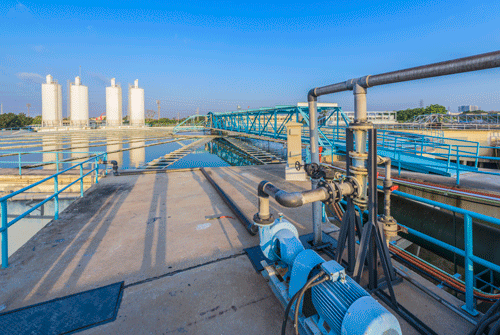
Per- and polyfluoroalkyl substances (PFAS) have taken center stage for utilities recently. Better known as forever chemicals to the public, these compounds are found in everyday products from raincoats to shampoos, and can cause adverse health effects ranging from inhibited fetal and infant growth to decreased immunity to kidney cancer.
Public awareness surrounding the toxic chemicals is at an all-time high, mainly attributable to recent actions by the United States Environmental Protection Agency (EPA). In late 2021, the agency unveiled its “PFAS Strategic Roadmap,” which outlined a three-year timeline of actions designed to clean up PFAS contamination.
Within the roadmap, the EPA indicated its intention to designate two of these harmful compounds, perfluorooctanoic acid (PFOA) and perfluorooctanesulfonic acid (PFOS), as hazardous materials, which would (without further legislative action) subject those discharging them to liability under the Comprehensive Environmental Response, Compensation, and Liability Act (CERCLA). Further, under Section 301 of the Clean Water Act (CWA), it is unlawful “for any person to discharge any pollutant into the waters of the United States without authorization.”
In early 2023, the first-ever proposed national standard for PFAS in drinking water was released, proposing a strict maximum contaminant level (MCL) of four parts per trillion (ppt) for PFOA and PFOS—two of the most common PFAS.
Looking Ahead: PFAS in Wastewater
Due to the widespread use of PFAS in commercial and consumer products, PFAS tends to concentrate in wastewater streams, making wastewater treatment plants potential avenues of PFAS contamination and the next focus of federal regulations. The EPA has already strongly encouraged wastewater treatment plants to test for suspected upstream PFAS sources using the latest sampling methods and recent effluent guidelines, and this may set the stage for stricter regulations, including monitoring and treatment requirements.
The EPA’s use of mandatory standards as part of the strategic roadmap has focused on potable water to date. However, the roadmap does contain a section on finalizing the risk assessment for PFOA and PFOS in biosolids, which is expected in the winter of 2024. Like the path taken on the drinking water side, many states have started enacting wastewater regulations for PFAS in the absence of federal guidelines to date. Maine, for example, prohibits spreading PFAS-laden sludge and sludge-derived compost as fertilizer, which has forced wastewater treaters into more costly disposal solutions for their biosolids.
At the same time, neighboring New Hampshire has authorized wastewater treatment plants to require upstream dischargers to test the discharge for PFAS. These testing efforts often precede regulatory action. Other states with policies either proposed or implemented include Illinois, Maryland, Minnesota, Rhode Island and Virginia.
PFAS Cleanup: A Costly Enterprise
As with their drinking water counterparts, the looming question remains for publicly owned treatment works (POTWs): Who will foot the bill for remediation?
Minimizing risk while keeping expenses low is a primary concern for wastewater agencies. Even though as passive receivers POTWs are not responsible for introducing PFAS into the environment initially, they may be saddled with the cost and responsibility of detection, clean-up and monitoring efforts.
Beyond the potential costs of PFAS clean-up and containment measures, operators may be required to pay for remediation activities, reimburse affected parties or invest in costly treatment technologies if found liable for PFAS contamination. Even if the EPA maintains its announced policy to focus on manufacturers and other business that use PFAS in their operations, rather than POTWs, wastewater operators remain open to lawsuits by private citizens and state regulators.
With such high stakes, wastewater treatment plants are beginning to evaluate the need for upgrading their treatment technologies to comply with potential new regulations.
PFAS Litigation Momentum & Historic Settlements for Drinking Water
The recent momentum generated by the ongoing litigation around PFAS contamination shows the promise of litigation as a cost recovery strategy for wastewater operators. The recently proposed DuPont and 3M settlements for drinking water systems, which combined provide utilities up to $13.685 billion to eradicate forever chemicals from drinking water supplies, are a result of the ongoing PFAS multidistrict litigation (MDL) in the U.S. district court in South Carolina.
More than 2,500 plaintiffs have filed against these, and other, chemical giants involved with making and selling PFAS. With 3M’s and DuPont’s recent efforts at settling with drinking water providers outside of court, momentum is building for other plaintiff groups involved—including wastewater systems.
As the attention of the public and regulators starts shifting towards wastewater, many systems are already looking to retain counsel and file a suit within the MDL to seek cost recovery for their PFAS contamination. These systems will rely on the expertise of specialized legal counsel who can advise on which litigation strategy is best for their clients’ needs.
PFAS Remediation: A Blueprint for a Cleaner Future
The presence of PFAS in wastewater poses a significant environmental and health challenge. By implementing robust monitoring, upgrading treatment infrastructure, preventing pollution at the source, promoting research and innovation and fostering collaboration, the wastewater industry can minimize the release of PFAS into the environment and protect ecosystems and human health.
But it comes at a cost. Urgent action is required to ensure utilities and their ratepayers are not the ones stuck footing the bill for treatment solutions. Wastewater treatment plants can be proactive, holding the companies that initially created PFAS contamination responsible. Getting legal assistance is a justified way to get the financial resources necessary to remove PFAS from wastewater, and from an economic standpoint, it may be the only way.

